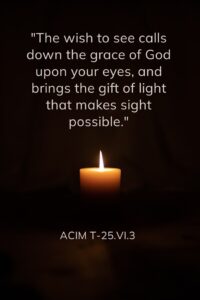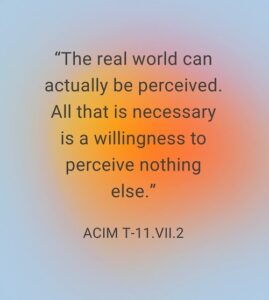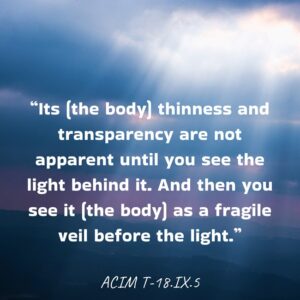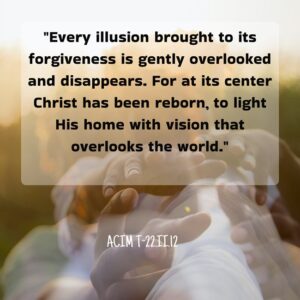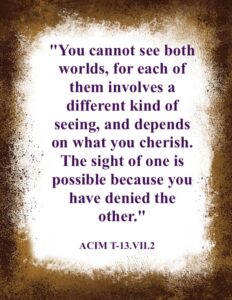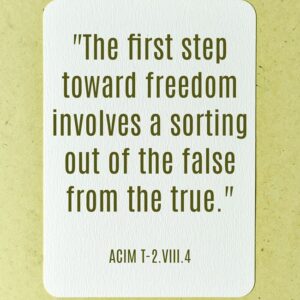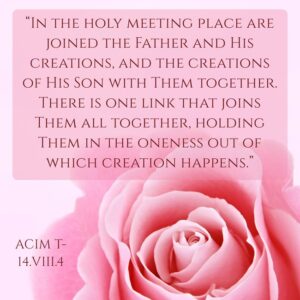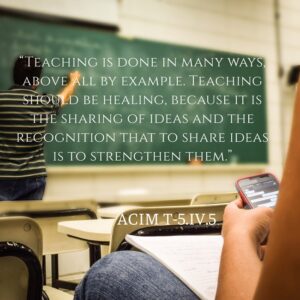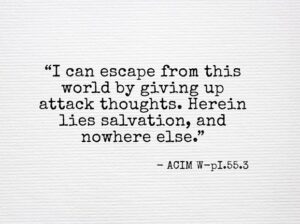
Escaping the World
A Course in Miracles gives us this curious statement:
“I can escape from this world by giving up attack thoughts. Herein lies salvation, and nowhere else.” W-pI.55.3
Then it says this:
“If the cause of the world you see is attack thoughts, you must learn that it is these thoughts which you do not want.” W-pI.23.2.
The discussion of giving up attack thoughts is not something I have seen discussed much by course students, but according to these and other statements our very salvation and awakening from the dream depend on it.
The interesting thing is that many students, including myself, do not see themselves as in the attack mode. Many students try to live so harmlessly that they even avoid stepping on a bug and feel that they do not want to attack anyone or anything.
What does this tell us?
It tells us that the Course is defining an attack on its own terms just as it does with numerous other words and phrases.
If you are seeing these words, you are still in this world, and according to the Course, you have not given up attacking.
What do you suppose it is that you are still attacking and what are these obscure attack thoughts we need to give up so we can go home?
The conundrum occurs for many students when they have seemed to do all they can to send love and not attack, yet still find themselves in the dream continuing to perceive with the physical eyes and senses.
Perhaps it would be helpful to examine more closely what the Course actually means when it speaks of giving up attacking and attack thoughts.
When most of us think of attacking we think of an action that hurts another person in some way. The Course seems to support this standard view in this quote:
“No one attacks without intent to hurt. This can have no exception.” W-pI.170.1
This tells us that attack involves an “intent to hurt” which is in harmony with the regular definition as accepted by the masses.
We can therefore say with certainty that words or actions meant to hurt someone physically or emotionally is an attack according to the Course.
But it seems that there is more to understanding attack than this for we are told: “I can escape from this world by giving up attack thoughts. Herein lies salvation, and nowhere else.” W-pI.55.3
It sounds like that if we simply give up thought with intent to hurt that we can escape this world and return in full to heaven. Yet there are many who do not seem to have any desire to hurt anyone, yet are still here seeing the physical world instead of the spiritual.
What are we missing?
Some think that any thought we have while in the separated state is an attack thought, even those we consider positive. Could this be true?
Not really, says the Course. Concerning our thoughts while in the dream it says:
“I have saved all your kindnesses and every loving thought you ever had. I have purified them of the errors that hid their light, and kept them for you in their own perfect radiance. They are beyond destruction.” T-5.IV.8
From this we learn that all thoughts associated with kindness and love are saved for us for they are “beyond destruction.” These are definitely not attack thoughts for we will take them with us back to our true home.
So what about the thoughts in between that do not have intent to hurt, but are not particularly loving? Suppose I think this:
“I am thirsty and must get a drink of water.”
That thought doesn’t seem to be attacking anyone, nor is it particularly loving unless one considers supplying the body’s needs as loving the body.
We do seem to think many thoughts throughout the day that have no intent to do harm, nor are they particularly loving. Could they be considered attack thoughts?
No. such thoughts by themselves are not attack thoughts for we are told that there are two thought systems. One is eternal and from God and the other is used by the ego. All of our thoughts then that are not associated with love and kindness are connected to the ego’s thought system, and this thought system governs the world. Concerning the world, the Course says
“The world was made as an attack on God.” W-pII.3.2
Why was the making of the world considered an attack on God? This gives us a clue:
To communicate is to join and to attack is to separate. T-8.VII.12
The separation and all that resulted from it is said to be part of the attack on God and this would include the world and our bodies within it for our bodies are a means to separate us from our brothers.
Even though many of our thoughts have no intent to hurt, our thought system as a whole is the result of the original separation.
We are told that all attack involves an intent to hurt. Was there really an intent to hurt our Father God in the original separation? This quote gives a clue”
“God would not have us be alone because He does not will to be alone. That is why He created His Son.” T-8.VI.8 “God is incomplete without you.” T-9.VIII.9
God created us because He did not want to be alone and if the separation would have been successful He would have been. The Sonship may not have directly wanted to hurt God by leaving him alone but its desire to separate would have had that effect if it had happened in the eternal reality. God did not allow a real separation so we had to make one in a dream world instead.
The ultimate giving up of attack thoughts then is to forgive the world itself which means to overlook the world, seek the true reality and return home.
A major step in this direction is taken when we cease embracing attack thoughts where there is conscious intent to hurt. This not only includes attack thoughts toward others, but ourselves as well.
In addition, there is one more category of attack that has to be overlooked.
“Without attack thoughts I could not see a world of attack. As forgiveness allows love to return to my awareness, I will see a world of peace and safety and joy. And it is this I choose to see, in place of what I look on now.” W-pI.55.3
It is notable then that the salvation promised by giving up attack thoughts includes those we see in the “world of attack.” The Course adds this:
“When you finally learn that thoughts of attack and of being attacked are not different, you will be ready to let the cause go.” W-pI.23.7
We as individuals may not be responsible for all the attack going on in the world, but it is the result of the split mind of the Sonship as a whole. Thoughts of you attacking, or outward attacks that affect you, are the same according to the Course and when we overlook both so they cease to exist in our minds it says “I will see a world of peace and safety and joy. And it is this I choose to see, in place of what I look on now.”
When we reach that place in our consciousness then the salvation promised for giving up attack thought becomes secured.
Yeah, I know it is hard to turn on the news and see nations attacking nations, politicians attacking politicians, thugs attacking little old ladies and then see “see a world of peace and safety and joy” in its place, but we are told it can be done because what we see is the result of our thought system, and there is another way of seeing.
In the meantime, we can all understand the first major step of “giving up” attack thoughts, or desire to retaliate against our brothers and sisters, and be as harmless as possible. When that is achieved our inward guidance will reveal the next step.
To search the website, containing millions of words, replace the word “search” with the word or phrase you want to find and place the entire line in the Google search box.
“Search” site:freeread.com
Check out JJ’s Facebook Group HERE
Join A Course in Miracles Discussion Group on X (Twitter) HERE
Access other articles associated with ACIM HERE
Check out JJ’s books on Amazon HERE
Easy Access to All the Writings
For Free Book go HERE and other books HERE
